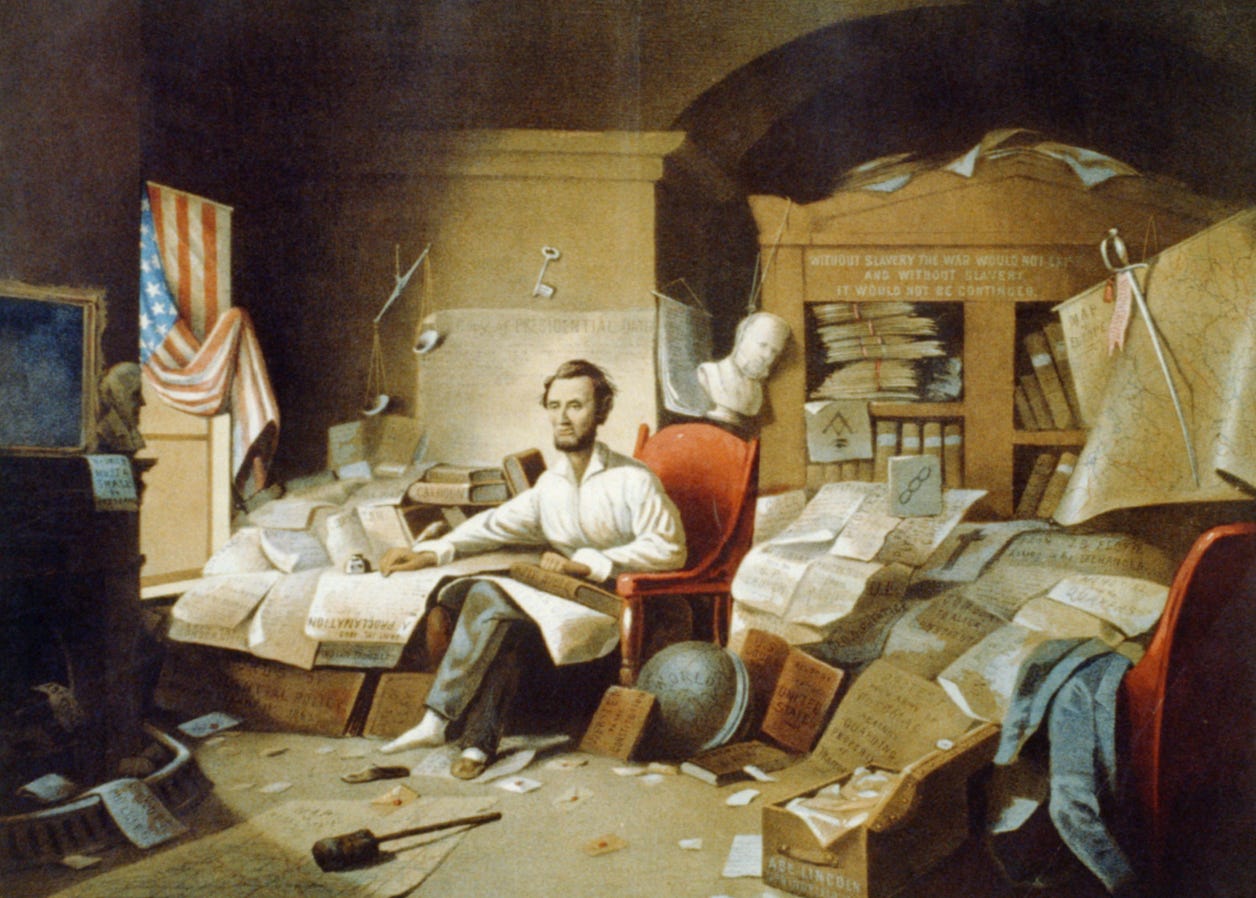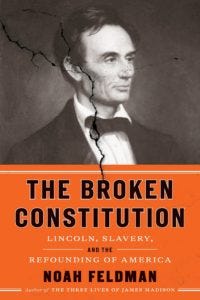

The Broken Constitution
Lincoln, Slavery, and the Refounding of America
by Noah Feldman
Farrar, Strauss and Giroux, 368 pp., $30
In the Gettysburg Address, Abraham Lincoln cast the nation as “conceived in liberty” and “dedicated to the proposition that all men are created equal.” In doing so, he drew on the Declaration of Independence, dating the founding of the nation to 1776, and not to the Constitution of 1787. The relationship between the principles put forward in the Declaration and the Constitution’s compromise with slavery has long vexed America. We have too often treated the compromise with slavery as a minor detail; in much of our public discussion about the founding, the “peculiar institution” is seen as deeply problematic but we gloss over the fact that it took a civil war, costing hundreds of thousands of American lives, to wash away America’s “original sin.” And we also gloss over the fact that it took the Civil War Amendments to recast the Constitution, making it “worthy of the saving.” Americans tend to treat the Constitution written in 1787 and set in motion in 1789 as the same Constitution we currently live under in 2022, as if slavery, civil war, and a second founding were just a few rough patches in an otherwise placid journey.
Noah Feldman’s The Broken Constitution eloquently and powerfully forces us to face these too often neglected questions. As Feldman tells it, Lincoln’s Gettysburg Address foreshadows the creation of a second Constitution—a better Constitution that places the moral principles of the Declaration at its heart. But to fully apprehend Lincoln’s refounding, we need to understand that Lincoln broke the original Constitution; yet we so live in the world remade by Lincoln that we have trouble glimpsing this fundamental rupture in our constitutional past, which cannot be neatly captured by singular dates like 1619 and 1776.
According to Feldman,
We think we understand the prewar Constitution, because the Constitution remains for us a living document, evidence of a continued commitment to freedom and self-government under the rule of law. Yet the Constitution had a different meaning and different functions before the Civil War than it did afterward. Above all, the antebellum Constitution was a blueprint for enabling the states to work together to preserve the union and expand it across the continent.
At the heart of the original Constitution was the compromise with slavery. So much so that Feldman refers to it as the compromise Constitution. We see the essence of this compromise in the Constitution’s clauses that obliquely refer to slavery. The first is the Three-fifths Clause, which counts enslaved persons as three-fifths of “free persons” for the purposes of representation. The second is the Slave Trade Clause, the limit on Congress’s power to prohibit the importation of slaves until 1808. The third is the Fugitive Slave Clause, guaranteeing that enslaved persons escaping to free states would not become free but would be returned to slavery in the state that recognized them as lawful property. These clauses enabled the formation of the original Constitution. As Alexander Hamilton argued at the New York ratifying convention, against the critics of the three-fifths compromise: it “was one result of the spirit of accommodation, which governed the Convention; and without this indulgence, no union could possibly have been formed.”
Beyond these formal provisions, the Constitution depended on and perpetuated a “federal consensus” that required maintaining the compromise around slavery. The Missouri Compromise of 1820, which struck a balance between free and slave states, is perhaps the most evident embodiment of this spirit in the antebellum period. Throughout his political career, Lincoln embraced the “federal consensus,” but he thought this included recognizing the moral wrong of slavery. In his Peoria Address in 1854, he complained that Senator Stephen Douglas was working to allow for the extension of slavery. Worse, Douglas was indifferent to the moral wrong of slavery. In criticizing the repeal of the Missouri Compromise, Lincoln urged that we return to the position of acknowledging the evil of slavery, while preventing its spread and thereby hastening its ultimate extinction. Lincoln elaborated on this point in his debates with Douglas in 1858, where he insisted “that the fathers of this Government” had placed slavery on a course for ultimate extinction because it was at odds with the “great fundamental truth” articulated in the Declaration that all men are created equal. But however evil, however wrong, preserving it where it already existed was constitutionally compelled. Lincoln stood, as he said in Peoria, “fairly, fully, and firmly” by the Constitution on this question. Lincoln’s complaints about the Dred Scott decision, which held that blacks—free or slave—could not be citizens of the United States and that Congress had no power to prohibit slavery in the territories, often focused on the fact that in breaking with the Missouri Compromise the decision broke with the central accommodation that held the Union together.
Even as states began seceding from the Union, Lincoln stuck by the compromise. In his First Inaugural, he reiterated the Republican platform of 1860, which reaffirmed “the maintenance inviolate of the rights of the States, and especially the right of each State to order and control its own domestic institutions according to its own judgment exclusively.” Slavery, in other words, was constitutionally protected in those states where it already existed; it was beyond the reach of the president and the Congress. Lincoln even endorsed, in a passage too often forgotten, an “irrevocable” constitutional amendment that would prohibit the federal government from interfering with slavery where it existed. If passed, this would have become the thirteenth amendment. Rather than abolishing slavery, it would have preserved in perpetuity the original compromise, which acquiesced to the fact of slavery.
Given all of this, Feldman concludes that the Lincoln elected in 1860 and inaugurated in 1861 did not “underst[and] the Constitution as an antislavery document.” This is less clear. Certainly, Lincoln did not think the Constitution was antislavery in the sense that it allowed any branch of the federal government to eradicate slavery. Institutionally, the Constitution was at best mixed and even leaned in a proslavery direction insofar as it gave outsized institutional power and weight to the slave states by way of the Three-fifths Clause. Yet insofar as the Constitution also embraced the idea of republican self-government, it could be understood to be at odds with slavery. Did a commitment to the idea of constitutional self-government require the ultimate extinction of slavery? Feldman argues that Lincoln ultimately came to this position, but that meant breaking the old Constitution and creating a new one.
Yet as we’ve seen, Lincoln displayed much of this mindset in the 1850s. As Feldman notes, Lincoln argued that we should understand the constitutional order the Framers sent in motion in aspirational terms: “They meant to set up a standard maxim for free society, which should be familiar to all, and revered by all.” But this would be something we aspired to as a nation—“looked” to and “labored” for—but “never perfectly attained.” The important point for Lincoln was that such a maxim included “all people of all colors everywhere.” This situated the ideas underlying the Constitution—the very idea of self-government—as at odds with the Constitution’s compromise on slavery; it was an implicit critique of the founding that pointed to the inadequacy of the original Constitution. In his Peoria Address Lincoln contended, “When the white man governs himself that is self-government; but when he governs himself, and also governs another man, that is more than self-government—that is despotism.” Yet until slavery was eradicated in the states where it already existed, we would have to live with this constitutional disharmony.
Feldman, though, downplays the fact that the original Constitution had elements that were clearly moral—the rule of law, liberty, and self-government all implied understandings of equality that were in tension with slavery. To play on an analogy Feldman powerfully invokes, if we think of the compromise Constitution and the amended Constitution that came out of the Civil War as akin to the Old and New Testaments, with the first being rooted in a rigid adherence to law and the second being rooted in moral understandings, there is more to the Old Testament than its insistence on law; there is an insistence, in the Prophets in particular, on the spirit and morality the law is meant to serve. To push Feldman’s analogy, the Old Testament had shoots that would grow in the New Testament: the moral and philosophical commitments of the new had roots in the old.
Indeed, Feldman captivatingly details how these strands were picked up by antislavery constitutional thinkers, abolitionists, and black Americans in particular, all of whom debated the Constitution and its relation to slavery in the antebellum years. The abolitionist William Lloyd Garrison’s insistence that the Constitution was a proslavery compromise with the devil is well known, while the abolitionist Lysander Spooner’s insistence that the Constitution, by self-consciously avoiding the use of the word slavery, provided no constitutional sanction to slavery, is less well known. Feldman brings these debates to life, particularly drawing on important but lesser-known black Americans.
One of the more fascinating debates took place in January 1851 at a state convention of the Colored Citizens of Ohio. The highlight of Feldman’s narrative is an exchange between Hezekiah Ford Douglas, “who had escaped enslavement at fifteen,” and William Howard Day, a free-born black man and graduate of Oberlin College. While Douglas insisted that blacks should not, in Feldman’s words, “acknowledge the legitimacy of a constitutional order based on slavery,” Day insisted that while the government was proslavery we should not confuse this “construction of the Constitution” with “the Constitution itself.” And the Constitution itself, framed to “establish justice” and to protect “liberty,” was best understood as antislavery. Fredrick Douglass drew on both strands of this debate, arguing in 1850 that “Liberty and Slavery” were both in the Constitution, giving us a constitution fundamentally “at war with itself.”
These tensions ultimately broke the original Constitution. Curiously, Feldman tends to highlight Lincoln’s breaking of the Constitution while downplaying how the Constitution was broken by the slave states and their Northern defenders. This is most evident in his discussion of the First Inaugural where Lincoln argued that the states did not have a constitutional right to secede, particularly on the grounds that they did not like the results of the election of 1860. The states might have a revolutionary right to dissolve the constitutional order and create a new one, but to secede because Lincoln was elected president when he had in no way altered the terms of the social contract was to evade the rules and break the constitutional order he was obligated to defend.
Contrary to Feldman, I think Lincoln’s First Inaugural is a powerful and compelling work of constitutional analysis. Lincoln’s message in the First Inaugural was twofold. First, he reiterated the compromise. Each state had a right to “control its own domestic institutions” (meaning, of course, slavery). All representatives had sworn an oath to support “the whole Constitution,” which obligated them to adhere to the fugitive slave clause as part of the compromise and not try to evade its terms by “hypercritical rules” of interpretation. But Lincoln went on to insist that no part of the Constitution had been violated. Given this, he argued that secession against a constitutional majority would be “the essence of anarchy.” If states could secede after an election rather than “acquiesce” to a free and fair election, then democratic government by a constitutional majority was no longer possible. Once ballots had settled the issue, states were constitutionally bound to oblige. Appealing to bullets was, as Lincoln put it, a “revolutionary” act that broke the constitutional order he had sworn an oath to uphold.
Feldman points out that Lincoln’s insistence on a majority as the sovereign was quite different from the Framers’ understanding of the sovereign, which they tended to treat as the whole people. But if the whole people had agreed to the Constitution, could part of the people break the Constitution because a majority of the people, by constitutional rules, had elected a president part of the people did not like? We might best understand this as a question of who is sovereign within the constitutional order, which is separate from who can act to dissolve the constitutional order itself. The most visible element of this debate was whether individual states were sovereign in the latter capacity: Could they exit the constitutional order? And if they could not constitutionally leave, did the national government have power to keep them in?
Events forced these questions on Lincoln. He found the answers proffered by his predecessor, President James Buchanan, less than compelling. If, as Buchanan held, the states had no constitutional right to secede, it was odd that the national government had no constitutional power to prevent them from leaving. Could a handful of states thereby dissolve the work of the people?
Whether America was a union founded by We the People or was a union founded by sovereign states was the subject of fraught debate in the antebellum period. The notion that the states were the central parties to the compact, and could possibly secede, found some support in Thomas Jefferson’s Kentucky Resolution and general ideas about the sovereignty of the states. Lincoln’s understanding also drew on a strand of constitutional thought that situated the people, and not the states, as central to the social contract. We see this logic in Chief Justice John Marshall’s opinions in Marbury v. Madison and McCulloch v. Maryland, where he positioned the people as the “original and supreme will” insisting that “the government of the Union . . . is, emphatically and truly, a government of the people. In form, and in substance, it emanates from them.” Senator Daniel Webster of Massachusetts, in his famous debates with Senator Robert Hayne of South Carolina, echoed Marshall’s understanding of the social compact as rooted in the people themselves, which Lincoln picked up on.
If Feldman on occasion downplays how the South broke the Constitution, and downplays, too, how Lincoln tapped into earlier strands of constitutional thinking, he convincingly elucidates how the broken Constitution provided Lincoln an opportunity to refound the Constitution.
The Emancipation Proclamation is the most profound expression of Lincoln’s changing position. He had long insisted that there was no constitutional power to alter slavery where it already existed. Yet with the Emancipation Proclamation, Lincoln claimed he had the constitutional authority to free the slaves in the states in rebellion as a necessary war measure. Feldman illuminates Lincoln’s shifting position, as he came to the ultimate conclusion that emancipation was constitutionally justified as a war measure in a time of actual rebellion. Part of this fascinating story is Feldman’s recovery of critics of Lincoln’s proclamation, like Benjamin Curtis, a former Supreme Court justice and one of two dissenters in the Dred Scott case. Curtis rejected the idea that the president, even as a war measure, could “repeal and annul valid state laws” that created and protected the institution of slavery. This was the position that Lincoln had long held, and continued to hold during the first few years of the war.
But the war highlighted the failure of the Constitution, which could not contain its fundamental disharmony on slavery. And the prolonged struggle forced Lincoln to confront the fact that the Union could not be brought back together on the terms of the old compromise. Feldman highlights Lincoln working through these fraught issues, revealing the alterations in his thinking. When, early in the fighting, in August 1861, Major General John C. Frémont freed the slaves of anyone in Missouri taking up arms against the United States, Lincoln formally reversed Frémont’s order. With the final Emancipation Proclamation, issued on January 1, 1863, Lincoln came to this position, declaring the slaves in the states in rebellion forever free as a war measure. Feldman’s subtle analysis of Lincoln’s evolution is refreshing, as Lincoln is too often treated as fully formed, or as a figure whose change of mind was mysterious or even inevitable. Feldman also highlights Lincoln as a theorist of constitutional necessity, as he is forced to confront thorny constitutional issues with no easy answer, which includes a detailed examination of Lincoln’s occasional overreach. Not only was his suspension of the writ of habeas corpus wider than necessary, but it included, Feldman writes, suspending “the basic constitutional right to free speech” and locking up critics of the war far more extensively than is usually acknowledged. Though we should also remember that the slave states brazenly silenced critics of slavery in the years before the war.
In addition to its justification on the grounds of military necessity, the final proclamation also appealed to “the considerate judgment of mankind, and the gracious favor of Almighty God.” Karl Marx, Feldman intriguingly points out, described this as “tantamount to the tearing up of the old American Constitution.” As Feldman has it: “By connecting the Emancipation Proclamation to the Declaration of Independence, Lincoln was trying to add it to the canon of foundational documents that the United States would give the world.”
The Emancipation Proclamation was a step to the “new birth of freedom” that Lincoln more fully articulated in the Gettysburg Address delivered eleven months later. Not only did the proclamation “recast the Civil War as a war about freedom and equality,” it suggested the nation “would repair the wrongs” of the old Constitution. Emancipation would be made permanent with the Thirteenth Amendment, abolishing slavery and destroying the compromise at the heart of the original Constitution: “The greater drama of the passage of the Thirteenth Amendment was its transformation of the prewar, compromise Constitution into a new Constitution that repudiated the very core of that compromise as it had existed from 1787 to 1861.” This second founding culminated in the Fourteenth and Fifteenth Amendments, inscribing the principles articulated in the Declaration and reaffirmed by the Gettysburg Address into constitutional text.
If Feldman positions the second Constitution as moral and the first as all compromise, downplaying some of important continuities between them, he is exquisitely right to force us to recognize the failures of the original Constitution. Americans—particularly those Americans who think patriotism depends on a belief in an infallible founding and a perfect Constitution—too easily gloss over how “complicated, contradictory, and fraught it was for Lincoln and the nation to overcome [the old] Constitution and remake it.” Beyond forcing us to confront the discontinuities of our constitutional history, taking in the tragic as well as the triumphant, Feldman’s The Broken Constitution is a timely reminder that the task of maintaining constitutional self-government is ongoing—the work of present generations building on the past.












